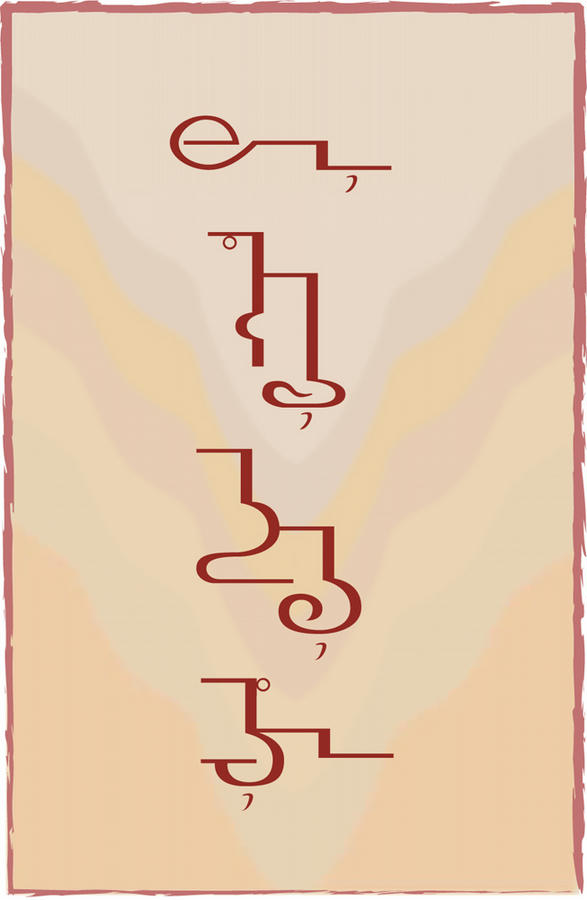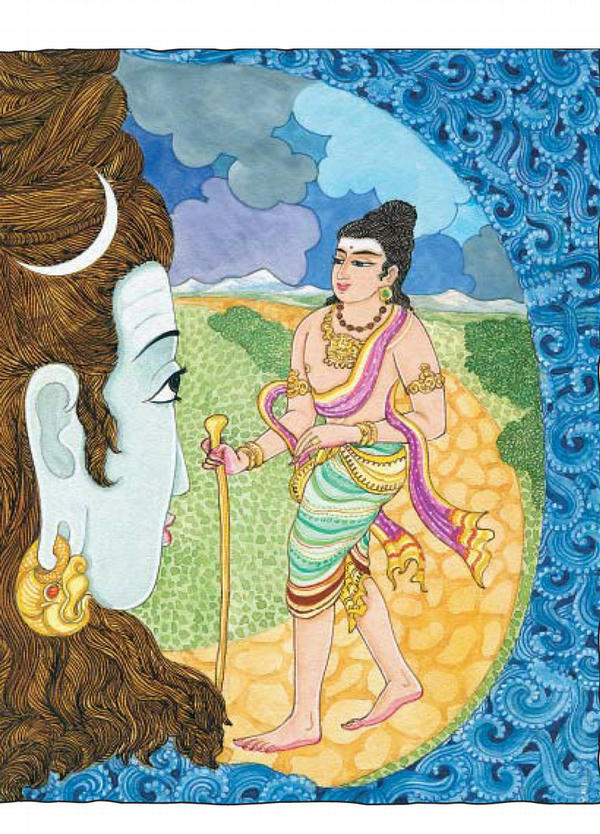8. Shum Perspective Meditation
Based on the August Mamsani
See yourself as awareness flowing from one area of the inner mind to another, the mind itself being stationary. All areas of the inner mind always exist. §
Move on to the next portion of the meditation by the command nīīmf simvūmkami meaning to internalize our awareness so that it is experiencing the fourth dimension. This dimension relates to the four kamshūmālingā rehmtyēnalī. Therefore, to experience the portraits within this dimension, look into the inner mind from the chest area. §
Find the state of consciousness that is intensely aware in the present moment, having let go of concerns and thoughts about the past and future. Look upon this state of consciousness as always existing. All you need to do is move awareness into §
In Shūm§
shūmīf §
nīīmf»§
simvūmkami§
bīsī»§

Quote from Gurudeva§
These four major perspectives of the consciousness of human beings create their major inner mind styling. There is no relationship to ordinary life within these perspectives. Not one of them is a second or third-dimensional picture. These are four names that capture and categorize consciousness into four divisions. Saivism can well name all four. A fully developed Saivite should be able to experience at will each of these four perspectives, consciously live in two, three or more at the same time, as did the rishis of yore.§
Supplementary Reading§
Twelve Shum Meditations Shum-Tyeif Meditation for the Mamsani of August§
This is one of our most delightful mamsanī, naming the four different focuses of consciousness. The intelligence within each one of these four can and has taken lifetimes to know, to memorize, to investigate, cognize and expand the mind into the depths which are there to be explored. But imagine this month gaining a superconscious glimpse of all four of these perspectives at one time: 1) Shūmīf is the perspective of awareness flowing through the mind, the mind itself being unmoved. 2) The simnīf perspective is its opposite; the mind is moving, and the intelligence of the person observing—such as a scientist looking through a microscope into the inner workings of matter—is stationary. 3) The mūlīf perspective is the way of words, the way of the scholars of philosophical intellect. 4) Its opposite is the dīmfī perspective, which is just now coming into focus on this planet through the newly found abilities of being able to communicate with Mahādevas, devas and beings of all kinds on other planets, such as the Pleiades, in this galaxy and beyond. Those in this perspective are not aware of being the center of all things, the shūmīf perspective. Nor are they aware of the world’s many philosophies, the mūlīf perspective. Nor are they much concerned about the nature of a drop of water, the simnīf perspective. Their minds fly high in dīmfī.§
In the small illustration on page 56, the six little lines going out from the center to simnīf, shūmīf, mūlīf and dīmfī represent the seven dimensions, for the circle in the middle represents the first dimension. The large curved lines as they relate to shūmīf and simnīf indicate a continuing out into inner space endlessly. But in the curve of the lines as they relate to dīmfī and mūlīf (if they were to continue around, they would make a closed-in circle), we can see the limited nature of these two areas of the mind. In these two perspectives, one can only go so far within until he is swung back into outer dimensions. Notice that in mūlīf and dīmfī the second and third dimensions are much bigger and more pronounced than the sixth and seventh dimensions, whereas it’s just the opposite in shūmīf and simnīf—the inner dimensions are more predominant.§
In the mūlīf and dīmfī perspectives, the dimensions start big and get smaller, because we are more in physical consciousness in these areas. The second is bigger than the third, because in the mūlīf and the dīmfī perspectives the physical world is more real than the third dimension, and the third is more real than the fourth. In shūmīf and simnīf we’re more in mind consciousness, devoid of physical consciousness and physical things. Therefore, we go on endlessly in the mind. Notice that in these two perspectives the seventh, sixth and fifth dimensions are all much bigger than the second dimension. And, of course, we come right down to the first dimension, which is the same in shūmīf, mūlīf, simnīf and dīmfī.§
You will find, when you meditate on this mamsanī, that the shūmīf and simnīf are companion states of consciousness and inner awareness, as are the mūlīf and dīmfī experiential perspectives of human consciousness and awareness.§
These four major perspectives of the consciousness of human beings create their major inner mind styling. There is no relationship to ordinary life within these perspectives. Not one of them is a second- or third-dimensional picture. These are four names that capture and categorize consciousness into four divisions. Śaivism can well name all four. A fully developed Śaivite should be able to experience at will each of these four perspectives, consciously live in two, three or more at the same time, as did the ṛishis of yore.§
shūmīf  18.41§
18.41§
1) One of four perspectives, the meditative viewpoint of being awareness flowing from one area of the inner mind to another, the mind itself being stationary; 2) the perspective of the Shūm-Tyēīf language; 3) it is also simply called the Shūm perspective; 4) in Śaiva Siddhānta it includes the deeper meditative practices; 5) it is advaita, or a monistic viewpoint.§
mūlīf  33.42§
33.42§
1) One of four perspectives, the philosophical viewpoint of understanding theological, metaphysical and psychological concepts; 2) realization is often attained simply through understanding deep philosophical concepts, which would be an intellectual realization, not a spiritual one; 3) in Śaiva Siddhānta it includes the intellectual study of Siddhānta philosophy; 4) it can be nondual, dual or both, depending on the comprehensiveness of the philosophy.§
simnīf  08.43§
08.43§
1) One of four perspectives, the scientific viewpoint of looking into matter; 2) in this perspective, the mind is moving and the intelligence of the observer is stationary; 3) understanding comes through observing matter and achieving insights into its behavior; 4) in Śaiva Siddhānta it includes the knowledge of haṭha yoga, prāṇāyāmas and the currents of the physical body; 5) it can be dual, nondual or both, depending on the inclusiveness of the scientific theory.§
dīmfī  68.01§
68.01§
1) One of four perspectives, the metaphysical viewpoint of looking into inner and outer space; 2) it is a perspective that acknowledges, understands and communicates with God and Gods, beings on the astral plane, people from other planets; 3) it is here that all psychic phenomena take place; 4) in Śaiva Siddhānta it includes the consciousness of the devas, Mahādevas and God Śiva experienced in the temple; 5) it is dvaita, or a dualistic viewpoint.§
Additional Vocabulary§
In addition to the words in the mamsanī, we will utilize the following Shūm words in our meditation. Their definitions are:§
bīsī  13.16.148§
13.16.148§
Eternal now. 1) Eternity of the moment felt in the middle of three days in the past and three in the future; 2) bīsī means “I am aware of the unreality of time and the eternity of the moment;” 3) have you noticed that any concern you might carry always bears upon the past or the future? 4) to dissolve any concern, therefore, all one has to do is guide awareness to the present; 5) living in the moment in the center of three days in the past and three days in the future is the spirit of bīsī.§
simvūmkamī  08.09.07.20§
08.09.07.20§
1) Dimension, fourth; subsuperconscious mind; 2) awareness cognizing the interrelated forces of the fifth, fourth and third dimensions; 3) from this detachment we gain the ability to dissolve confusions, conflicts and the various and varied entanglements that are encountered daily; 4) the realm of artistic creativity; 5) here is the resting place where we look in and up and out and down; 6) consciousness should never go lower but when soaring higher returns to the resting place within the fourth dimension; 7) this dimension relates to the kamshūmālingā rehmtyēnalī; 8) to experience the portraits within this dimension, look at the world from the chest area. §
Additional Resources§
Merging with Śiva, Chapter 30: The Nature of Thought§

